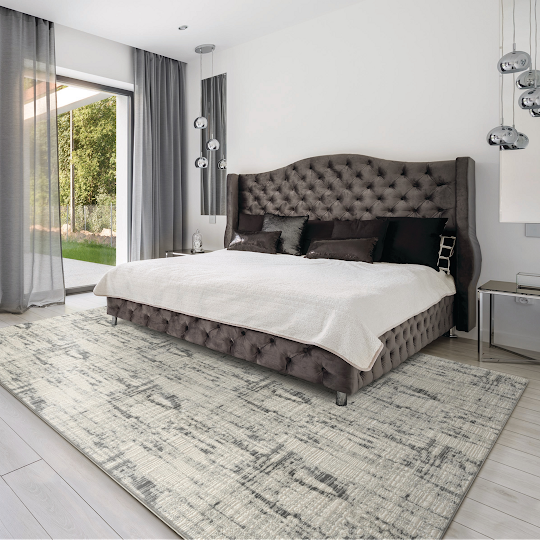
As fine rug specialists, we know that nothing quite ties a room together like an area rug! Our showrooms in Guilford and Orange are fully stocked with traditional, contemporary and transitional styles for a variety of applications and prices in home and office settings.
Area rugs come in a range of sizes and can also be customized to fit your specific measurements. To create an inviting and comfortable living or office space, use these tips to select the right size rug.
Identify the Area for a Rug
Measurements give our rug experts a better idea of the space you have. Smaller rugs and floor runners are ideal for entryways, foyers, bathrooms and kitchens, while living rooms, bedrooms, dining rooms and offices usually benefit from larger rugs. Floor and stair runners are perfect for accenting hallways, staircases or placing alongside a bed or kitchen island.
Placement Based on Room
Area rugs are designed to bring color and comfort to a room. In terms of sizing, area rugs are very forgiving. There are no set “rules” to determine a specific size in relation to room size. If a warm and cozy feeling is desired, a rug nestled with your furniture anchoring the rug will fit the bill, while leaving a beautiful wood or tile floor as a border.
This look especially comes in handy when the room is extremely large and can create several seating areas if desired. To create a more formal look, a larger rug with furniture placed completely on top will give more of an expansive feel. Pictures of the space will give us an even better visual!
Living Rooms & Dens
Typically, the seating area is the primary focus of a living room or den. When it comes to placing furniture, the front legs of a sofa should anchor onto the edge of the rug. If a room has multiple sitting areas, lay multiple rugs down to frame them. For a more formal look, a large rug with the furniture completely on top will fit the bill.
Dining Rooms
Bigger is typically better for dining room settings. When working with a dining room, the best way to determine how large of a rug you need will depend on the size of the dining room furniture itself. Ideally, the rug should be large enough to ensure that dining room chairs on all sides of the table STAY on the rug when they are pulled out to sit or stand.
Also, the rug should NOT go underneath the China cabinet or hutch if at all possible. This will prevent catching the char legs on the edge of the rug, which becomes a nuisance and can damage the rug or furniture itself.
Bedrooms
Area rugs in the bedroom should also be large. Each corner of the bedframe should anchor the rug, showing one to two feet of material around all sides. Choosing a rug that’s larger than the bed provides soft cushioning underfoot when you get up!
Offices
Similar to the dining room setup, an office rug should be large enough for a desk and chair to remain completely on, with one to three feet of wood showing around.
Kitchens
A small accent rug or runner can be perfect for the kitchen. Runners help visually extend the length of the room when placed about six inches from an island or base of lower cabinets.
Floor & Stair Runners
Floor runners are perfect for brightening up a dark hallway or adding depth to a narrow walkway. A runner should extend from one side of the hall to the other, with about 6 to 12 inches of bare floor at each end.
Staircase runners create a grand welcome, provide cushioning and can help combat slippery hardwood. They are also great for absorbing noise that can travel to bedrooms. They cover each step, so you’ll need to count the total number, measure the step depth and riser height for the appropriate length stair runner.
Measuring the width of the staircase is important as well. We typically would like to see 5 or more inches of wood on each side of the runner to establish a nice frame around the runner. Pictures are perfect in this situation too!
To learn more about our interior rug design services and explore our vast inventory, visit a showroom today!


